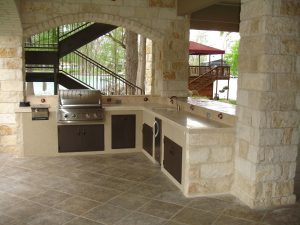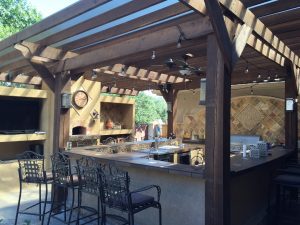 Before going shopping or hiring contractors, learn these 10 design tips for your outdoor kitchen. This handy guide will save you money, bring some things to light that you may not have thought about.
Before going shopping or hiring contractors, learn these 10 design tips for your outdoor kitchen. This handy guide will save you money, bring some things to light that you may not have thought about.
- Location – Choose the location wisely, so as to maximize the quality of your cooking experience.
- Climate – The climate you live in will determine much of the materials, and overall design of your outdoor kitchen.
- Materials – The quality of materials you choose will determine the life of your kitchen, along with the user experience.
- Layout – Possibly the most important consideration is the layout. Remember the 4 zones and how they will affect your ease of cooking and meal preparation.
- Dining Area – Think about the dining area carefully. There are ways to create or incorporate a dining area even if you’re tight on space.
- Entertainment – Incorporating entertainment into your backyard kitchen, can elevate the enjoyment of your guests or family greatly.
- Appliances – Make sure to get a nice set of mid-range appliances. You don’t need to break the bank, or conversely buy garage sale quality appliances.
- Storage – Absolutely make sure you have ample storage space. Get creative if you need to, and make sure you get cabinets, storage boxes etc., that can withstand the elements.
- Energy – Make sure you have ample electricity to run your devices and entertainment needs. Plan carefully for all your energy requirements.
- Theme – This is one of the first things you will need to think about when planning your kitchen. This is the overall personality and style of your outdoor cooking space.
10 Design tips for your Outdoor Kitchen
You’ve seen the pictures and they’ve caused you to be lost in daydreams about an amazing outdoor kitchen. You can use these spaces to host all sort of guests, from friends and family, or simply a way to relax by yourself.
These spots come in all sorts of styles, colors, and can be incorporated with a wide range of other activities to really make them stand out. Being big or small, classical looking or ultra modern, an outdoor cookery can seemingly have a personality and life of its own.
Before you go down the path of creating your own outdoor kitchen though, you can probably imagine there are many things you need to keep in mind.
There is all sorts of planning and budgeting that needs to be done, along with potentially tremendous amount of carpentry, plumbing, and electrical works that can go into it. All in all this can be a bit overwhelming if you don’t know where to start.
Whatever your ultimate goal is for your outdoor space, make sure to always have these 10 design tips for your outdoor kitchen handy to guide you along, if this is your chosen route.
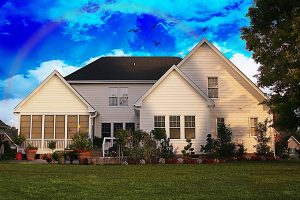 1. Location
1. Location
To begin you need to pick the spot that your outdoor kitchen is going to be located. Picking the incorrect spot can cause greatly reduce the quality of your experience. Ideally you want to pick a location that is close to your indoor kitchen, as this allows you the flexibility to take food in and out.
A well placed outdoor canteen should have a direct connection to the interior. When you are figuring out the right spot, keep in mind the movement of the sun.
Chances are, unless you invest into some sort of source of heat – things like fire pits, fireplaces, and patio heaters – you’re going to do most of your hosting during the warmer months. This means the trajectory of the sun will be located at the East to West extremes.
If you are going to keep the spot viable during the winter months, keep in mind that the sun will then be located closer to the horizon. If you can use natural sources of shade all the better, if not you’re going to have to incorporate the walls to cover these up.
From here you just want to get a spot that is relatively horizontal – anything on a slope will need to be built up or dug down to create a flatter plane.
2. Climate
This is an ever present issue when it comes to just about any construction project, but influences an outdoor kitchen even more.
Climate zones can determine a wide variety of things from materials to layout. If you live in a warmer area you’re going to want to invest into a cooling system – think along the lines of fans and a layout that is open enough for air circulation while also being shaded from the sun.
Cooler areas will need the opposite – fire pits can be a great addition, but can take up a lot of space. Fireplaces on the other hand can create a great focal point if properly integrated, but need a deal more time, money, and labor put into them. In a pinch a patio heater can work wonders – these are typically propane powered and heat up a large area.
Coastal areas on the other hand have their own special set of problems – salt in the water and the air is highly corrosive to most materials. For extra protection you should invest into products with additional layers of protection, like a powdery coat finish or something rated for humid air.
In a stormy area you should have large appliances and items bolted down, while things like chairs, bar stools, and tables need to have an area they can be safely stored.
 3.
3.  Quality of Materials
Quality of Materials
The quality of the materials is especially important when doing any outdoor construction project. The added hurdle when it comes with an outside kitchen is that you’re going to want it to look good as well.
As expected, materials that cost more typically last longer – but isn’t always the case as the climate you live in can have detrimental effects on it. Things like polyethylene wicker, teak wood, and limestone are simultaneously hardy and beautiful looking.
Many products, such as quartz and marble, come with built in UV inhibitors to resist the damaging effects of the sun. Stainless steel is usually a good choice – but be careful on what type you get in coastal areas. The grade 304 stainless steel is the most common, but can actually corrode in salty air, while grade 316 stainless steel is specifically rated for these areas.
If you’re thinking of incorporating tiles into this area, it is recommended to invest into something that is certified for moist conditions like bathrooms. Naturally, glossy tile has a tendency to be more water resistant, but much more slippery. More porous tiles in contrast have a much better grip but are more susceptible to water damage.
Whatever you go with make sure to use sealers as they can greatly increase the lifespan of tile – along with many other products creating additional protection for stone, concrete, and wood. Make sure to keep in mind weather and temperature fluctuations – the natural expansion and contraction that occurs during the year can crack or break some materials.
When figuring out your style don’t be afraid to combine many different materials together – brick, wood, stone, steel, and plastic can all sync up beautifully.
4. Layout
The layout is probably one of the most important considerations when designing your outdoor kitchen. Thankfully, many indoor configuration can work pretty well – as long as you keep in mind the intrinsic limitations of an outdoor space.
Every good kitchen layout has four specific zones: Cold, hot, wet, and dry. The cold area is where the refrigeration area is at, while the hot spot is all about where you’ll be doing the actual cooking.
Wet and dry refers to the sink and counter space respectively.
When laying out the layout, so to speak, you need have all four of these zones work in tandem with one another. For instance you should have a rational space between the wet and hot zones, as you don’t want the chef to be interrupted from someone washing their hands while they are cooking.
Try to keep a balance between your cooking area and your entertainment and dining spots. Space is always an important factor in this – while having that island of appliances might be ideal, you might need to settle for something more streamlined if you are limited on space.
Using cabinets, shelves, and things like bars effectively can cut back on unnecessary clutter and create a more welcoming and open spot for your guests.

 5. Dining Area
5. Dining Area
A good dining area is a great spot for people to eat and converse – if you have the space, having an outdoor space dedicated to dining can really do wonders in conjunction with your cookery.
You’re going to want to pick a dining set that works well with your theme, while also being low maintenance enough to clean and upkeep. If you need to you can incorporate a dining area into an already existing spot – by using a set of tables that either fold up or expand you can convert it at your whim.
Another good way to get a dining area if you’re short on space is to actually combine it with your cooking area – a bar set up can have the guests facing the cooking station, allowing banter between them and the cook.
To maximize comfort weatherproof patio cushions are available. If you live in a humid area that is prone to mosquitoes, try to install a bug light or two to zap them away from your dining area.
6. Entertainment
To streamline this you can build your outdoor kitchen in conjunction with an existing area like a pool. If you do, do something like this make sure to keep your kitchen dry enough to cook fine.
Hot tubs can be a great addition, especially alongside a drink cooler or bar. Something like an outdoor pool table or ping pong table can be really neat, but it is recommended to invest into additional protections like a vinyl cover to repel the deleterious effects of the elements.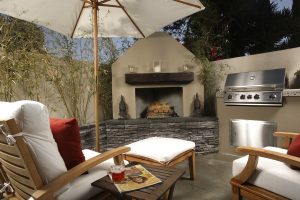
A TV can be incorporated in an enclosed wall, while a speaker system is a fairly easy install procedure with wireless speakers.
To improve the flow of conversation there are raised dining tables typically referred to as wine and dines that are specifically made for face to face interaction. Also try to incorporate some comfortable areas too – think like couches or loveseats that can be reclined in after a heavy meal.
If you have fireplace, having a couple of these sitting areas near here can be a great conversation spot.
7. Appliances
Just about any appliance that could go into your indoor kitchen can be incorporated into your outdoor one. While you don’t necessarily need the creme-de-la-creme machines, you don’t want the bottom of the barrel either.
Refrigerators and beverage coolers can be pushed out of the way into an appliances closet with fancy wood slatted door. For better access to the drinks while also keeping people out of the way of the main cooking area, try getting a separate drink cooler and putting it into the entertainment or dining area.
Stoves or grills should be large enough to get the job done, but not take up too much counter space. When choosing what to cook with also try to budget to your needs – that multiple platform, several burner infrared grills with rotisserie might look gre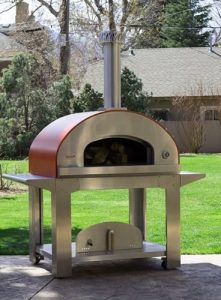 at in the store, but it might be well outside what you need.
at in the store, but it might be well outside what you need.
If you aren’t going to do much baking, you can get the oven top just by itself, and get a little bit extra storage space underneath.
If you are handy enough or if your budget allows for it, something like a pizza oven can look great in your kitchen area. You can get a mass produced model made from metal if you are going for an overall modern look, while a brick and mortar outdoor pizza oven looks really old fashioned.
When getting a sink and deciding on the area to put it, try to have it branch off existing piping. Below freezing climates will need insulated piping and way to drain the water from the pipes. While something like a dishwasher can seem a little silly, these machines can be incorporated relatively easy in the wet section of your layout.
Don’t be afraid to get smaller appliances like blenders, food processors, mixers, and the like into your area as well.
Sidenote: Be sure to check out our free small appliance buying guide.
8. Outdoor Kitchen Storage
When you are picking out cabinets and shelves, make sure you are getting things that will hold up in different types of weather and temperatures.
If you are short in space get creative with the design or layout of your kitchen to include more storage. Try attaching a magnetized shelf to the side of your refrigerator to hold spices or use the inside of the cabinets as a spot for holders and hooks for your cooking utensils.
The above space can be taken advantage of too by including a pot holder that hangs from the ceiling. Just keep in mind that despite how hardy they are, not all dining and food prep items are made for the outdoors.
Critters too can be more of a problem, as there is nothing really stopping them from entering your outdoor kitchen and rummaging around. Basic child locks can be attached to the inside of cabinet drawers and pulls to deter them, while airtight containers can do wonder against the protection of humidity and mold.
If you are really short on space, you can keep your outdoor cooking items in a plastic container located inside, taking it out when you move outside to cook.
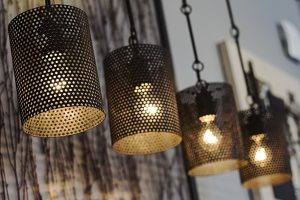 9. Energy
9. Energy
The modern kitchen has plenty of different gadgets and machinery to make a great meal – an outdoor variant has this multiplied with its inclusion of entertainment and dining spaces.
Having all the power necessary to do all your baking, frying, freezing an entertaining is integral.
On top of this you need to keep in mind having the right lighting based on your theme. Is your theme colorful and cheerful? Then lots of bright lights are what you’ll need. If you’re going for a more laid back and soothing atmosphere, dimmer lighting is probably more your style.
Whatever you pick doesn’t have to rely on typical light fixtures either, as something like string lighting can be great too.
If you are using electricity for most of your needs, you’re going to need plenty of electrical work done. Have plenty of outlets installed into walls and countertops, as an unsightly extension cord is never wanted. To cut back on your power bill you can have some of your larger appliances run off of gas.
Propane needs to be consistently refilled but can be purchased in multiple local locations, while natural gas is more convenient and cheaper, but isn’t available to everyone.
You can get creative to and incorporate something like pizza oven into your cooking scheme – these ovens burn wood and can be used to cook all sorts of things outside of just pizza like meat, fish, vegetables, and even bread.
75 Outdoor Kitchen Designs
CLICK THE VIDEO
10. Theme
This is no doubt one of the first things you thought of when thinking about an outdoor kitchen. While it’s important to have everything down pat first before you start to get too ahead of yourself, the theme is the overall personality of your new outdoor kitchen.
The theme should be seamlessly intertwined with the overall layout – for instance, if you’re going for more of a beach theme you should probably have some sort of tiki themed bar set up as a drinking area. For more rustic look you can include a bunch stone styles – with some companies offering some that are already weathered for a better look.
Things like appliance selection can influence this too, with brick fireplaces and pizza ovens giving a nice traditional look. Lots of rectangles, grids, and straight lines mixed with a juxtaposition of blacks and whites can make for a great modern look.
Open space shelving with white plates and colorful sashes can give your outdoor kitchen a more bohemian style. While columns can give you the opportunity to add extra personality to your outdoor area
Final Thoughts
These are my 10 Design tips for your Outdoor Kitchen. While there are more considerations, these 10 tips will definitely give you a great start and a layout to work from.
- An outdoor kitchen space can be a wonderful addition to just about any home. When you’re setting out your plans make sure that you have a good location in mind while always being vigilant about the climate – as this can influence just about everything you do.
- Overall layout should be rational, while the materials you pick need to be both beautiful and tough enough to withstand temperature and weather changes. If you can swing it, inclusion of a dining and entertainment area will greatly take advantage of this area.
- While picking the proper appliances, storage space, and meeting your energy needs will set you down the path for success.
- Like any other construction project you always should have a budget in mind. Do plenty of research so you can have a line by line list of what you can spend and where so you don’t go over.
- If you do go with outside help to get all this work done, always go with a certified contractor. The inexperienced help can create more problems than they are worth, while also wasting your time and money.

